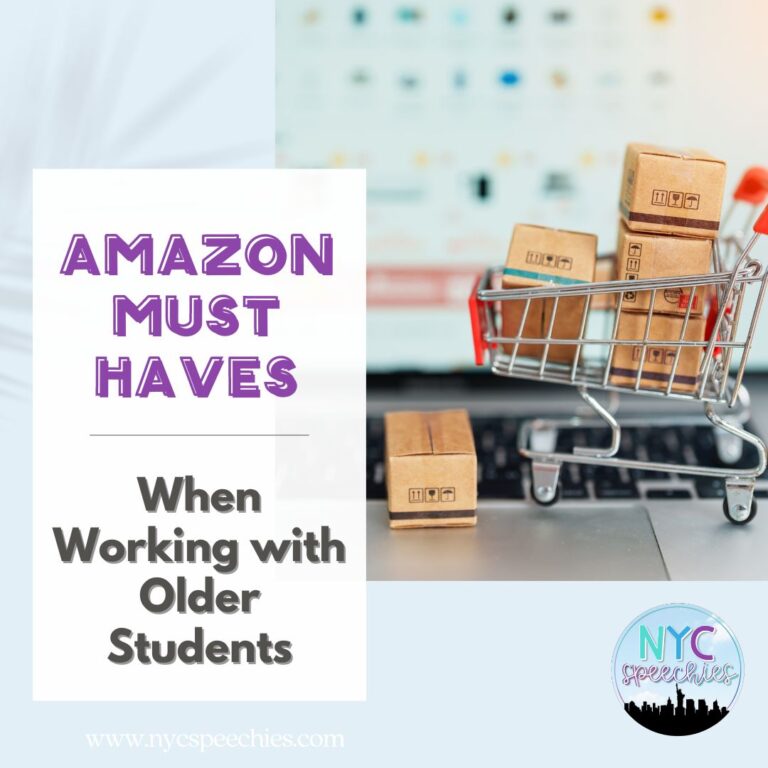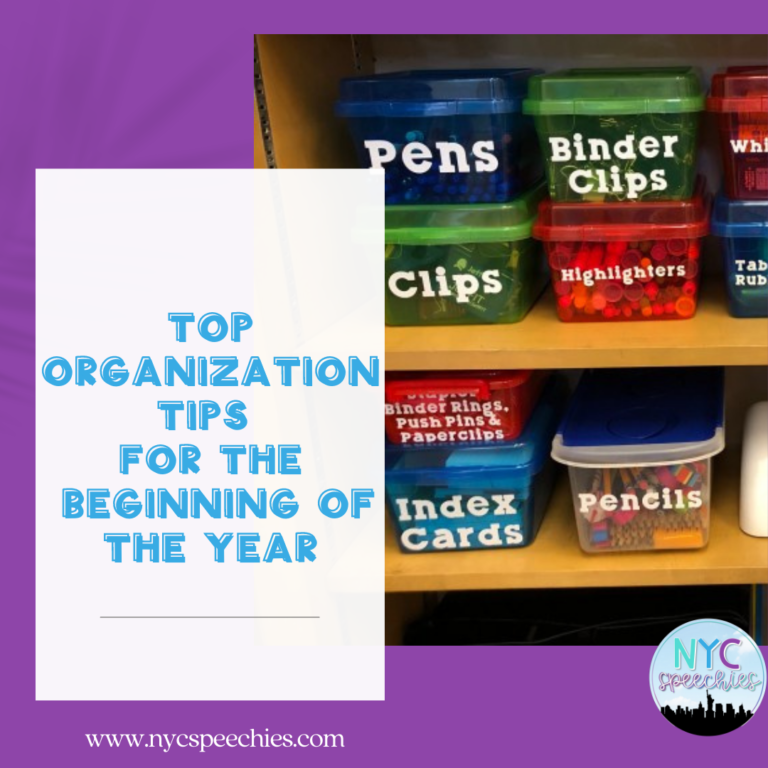Guide for the School-Based SLP
 We were very lucky to have had the chance to supervise a student-teacher last spring, so why not make a packet full of helpful resources for her? This was a useful guide to give her at the beginning of her experience. She was so thankful and used it everyday. It helped to keep her organized, professional, and was a great resource for her to refer to. This is a great guide for a clinical educator or mentor to present to a student-teacher or clinical fellow (CF). It’s an easy way to keep track of their teaching hours, monitor their progress, and offer support when working with any age group – elementary, middle, or high school students.
We were very lucky to have had the chance to supervise a student-teacher last spring, so why not make a packet full of helpful resources for her? This was a useful guide to give her at the beginning of her experience. She was so thankful and used it everyday. It helped to keep her organized, professional, and was a great resource for her to refer to. This is a great guide for a clinical educator or mentor to present to a student-teacher or clinical fellow (CF). It’s an easy way to keep track of their teaching hours, monitor their progress, and offer support when working with any age group – elementary, middle, or high school students.
To give this resource a more formal look when we handed it to our student-teacher, we binded it instead of just putting a staple in the top left corner. We have gotten so much use out of our binding machine. We bind all of our packets and important resources, as well as other resources we have purchased from other TPT teacher authors. We use transparent front and back covers to keep the inside pages clean and crease free. If you don’t have access to a binding machine, no worries. You can take a trip to Staples and they can bind it with clear front and back covers for a small fee.
Enough about the binding machine, let’s get back to the Guide for the School Based SLP! We always talk to our students about the importance of executive functioning skills, so with that topic in mind, we created this guide for our student-teacher. With the massive amounts of paperwork and responsibilities we have as SLPs, it’s important to put our executive functioning skills to use. Juggling all of these tasks and staying on track can be difficult. Keep reading to see how the Guide for the School Based SLP can help support any SLP working in a school.
Getting Started
The first section of this guide is geared more towards a clinical educator or mentor and their CF or student-teacher. It includes an introduction, getting to know each other, and becoming acquainted with the school building.
Contact Information: Get comfortable with each other and share contact information. You will be contacting each other quite often while working together.
Gaining Experience and Competence: Provide the student-teacher with an outline of expectations, this way they know what their role and responsibilities are while gaining experience in the school setting.
Past Experience Intake Form: This form gives the clinical educator a better sense of the student-teachers prior experiences, including placements and clients they’ve worked with.
School Calendar: Include the school calendar, this way they are aware of important school events and breaks.
School Time Schedule: Include the bell schedule. All schools have different times or periods they follow. Elementary schools may have 30 minute sessions, while a high school might have 40 minute periods.
Speech & Language Schedule: Fill in the time and group sessions on this schedule. Include student names and mandates. We print this schedule out once a week to help us keep track of our attendance by highlighting students who are present.
Sign-In Sheet: Keep track and log the student-teachers hours on a timesheet.
Goal Writing

Finding the right wording to write a speech and language goal can be challenging, therefore we’ve included this section to focus on writing speech and language goals.
Creating a SMART Goal: We break down the goal writing process by creating a SMART goal: specific, measurable, achievable, realistic, and timely for our students. To make it even easier, check out our Speech and Language High School IEP Goal Bank-Bundle. We’ve included goals from over 10 areas including reading comprehension, writing, executive function, pragmatics, vocabulary, oral language, fluency, and transition skills just to name a few.
Creating a Professional Goal: While you’re at it, create a professional goal for yourself.
Hierarchy of Support & Types of Prompts/Cues: Keep this in mind when writing a goal. Students may need additional supports and prompts to achieve their speech and language goals.
 Lesson Planning
Lesson Planning
This next section is filled with so much information. And lucky for you, most of the information discussed here is provided to you on TPT. Lesson Planning for the School Based SLP is a very helpful resource to refer to when writing a lesson plan and it’s FREE!
Lesson Planning: It’s important to always have a lesson plan available to show anyone who may walk in on your session. We provide a detailed outline of the different parts of a lesson. We include a sample lesson plan from one of our top selling vocabulary packets. This sample lesson plan gives you a better idea of how we write our lesson plans. This section also provides an opportunity for the student-teacher to create their own activity, write a lesson plan, and execute a lesson. Most importantly, don’t forget to collect data to monitor progress during the therapy session. After the lesson, the clinical educator can evaluate the student-teacher’s performance and provide feedback.
Weekly Calendar Lesson Planning: Keep track of lessons on a weekly basis. This gives you an idea of what you will do with your students each week. We like to incorporate our holiday themed or seasonal activities into our planning. We’ve also even included an annual calendar in the resource guide to help plan out the entire school year.
Weekly Reflection: At the end of the week, the student-teacher can reflect on their speech and language therapy sessions and complete follow-up questions. This provides them with information to help guide their therapy and change anything that may not be working.
Clinical Educator Feedback: Clinical educators can provide their student-teacher with feedback on a weekly or monthly basis so that the student-teacher is aware of areas of strength and areas they need to improve in.
 Individualized Education Plan
Individualized Education Plan
This section provides valuable information when it comes to preparing for, attending, and writing an Individualized Education Plan (IEP).
Preparing for an IEP Meeting: We’ve provided you with information about how to prepare for an IEP meeting and what should be included in your IEP report write up. It’s important to include the teachers voice, parent voice, and student voice in your report. Also, make sure to take good notes at the meeting, writing down any important information that needs to be shared or discussed with the family.
Helpful Forms
This section includes forms that we typically make copies of and fill out at the beginning of the school year.
Student Contact Information: Keep all of you students’ personal information in one spot. Refer to this when you need to reach out to the student or their family via phone, e-mail or even snail mail. We fill out one form per student and keep this in a binder along with their communication log.
Communication Log: Keep track and document all outreach including communication with parents, teachers, students, guidance counselors, social workers, and anyone else you speak with about the student.
Late Pass: Students often stay past the bell to speak with us and in this case we make sure to give them a late pass so they don’t get in trouble for being late to their next class. You can pre-print multiple copies to always have on hand.
Reminder Pass: Send this pass out in the morning to remind students that they have a speech session that day. After implementing this pass, we noticed an increase in student attendance!
Finally, we share our favorite websites, supportive social media groups on Instagram and Facebook, and our favorite products!
We created this resource to help support a school-based SLP at any point in their career, whether you’re a student-teacher, new graduate, clinical fellow, or experienced SLP who has now become a mentor or clinical educator. We wish we would have received this guide from our clinical educators when we first started our student-teaching experiences, it would have made our lives a whole lot easier!






